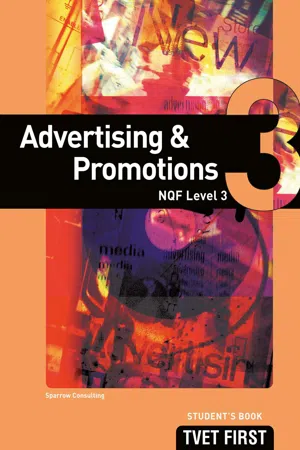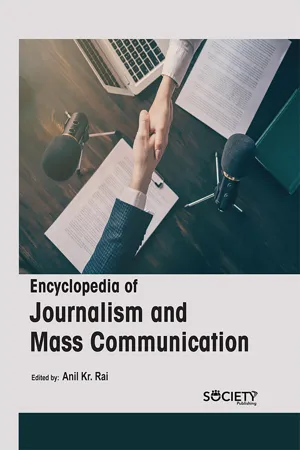Marketing
Advertising media
Advertising media refers to the various channels and platforms used to deliver promotional messages to a target audience. This can include traditional media such as television, radio, and print, as well as digital media like social media, websites, and mobile apps. The choice of advertising media is crucial in reaching the right audience and achieving marketing objectives.
Written by Perlego with AI-assistance
Related key terms
1 of 5
6 Key excerpts on "Advertising media"
- eBook - PDF
Advertising & Promotions NQF3 SB
TVET FIRST
- Sparrow Consulting(Author)
- 2013(Publication Date)
- Macmillan(Publisher)
Television, radio and magazines are examples of media . Later on, you will learn about the different types of media in more detail. First, you have to know how and why marketers use media. Media in the marketing environment Media are devices, channels or means that marketers use to communicate with, or reach large numbers of people. Marketers use the media to show advertisements in order to reach target consumers . For example, if a company wants to advertise its new product, it may broadcast an advertisement on the radio or television, or place an advert in a newspaper to reach potential consumers. An important part of a marketer’s job is to choose the most suitable media for getting the advertising message across to target consumers. The good news is that there is a large variety of media to choose from, such as television, radio, newspapers, magazines, billboards and the Internet. The bad news is that it is not always a straightforward decision, as there are also many media vehicles to choose from. To choose the right medium for your advertisement, you have to think about two things in particular: • The budget. • The target market. Interact : To act together with something. Media : Devices or means used to communicate with, or reach many people. Target consumer : The person you want to talk to, or reach, with your advertisement. Media vehicle: A particular instance of a medium. For example, the Sunday Times is a particular newspaper. In other words, the Sunday Times would be a media vehicle and a newspaper would be the medium. Words & Terms Figure 1.1: When you watch television, you are using an audiovisual medium. Example If you want to advertise a new cellphone to teenagers, you have to think about which type of media they use. Teenagers generally watch more television than read newspapers, so television would be a better choice to reach the teenage market. Figure 1.2: Think about what type of media your target consumer uses. - eBook - PDF
Principles and Practice of Social Marketing
An International Perspective
- Rob Donovan, Nadine Henley(Authors)
- 2010(Publication Date)
- Cambridge University Press(Publisher)
320 12 Using media in social marketing The availability and types of media channels today have expanded substantially since the first edition of this book in 2003. However, in keeping (at least somewhat) with that old saying that the more things change, the more they stay the same, recent global award winning advertising campaigns have been characterised by an emphasis on what people are now calling ‘traditional’ media channels: commercial television; commercial radio; print; and ambient media (Dawson 2009 ; Lannon 2008 ). For example, the Dove campaign we noted in Chapter 9 used viral ads and the Internet, but its major impact was via television advertising and the numerous well placed billboards – that were picked up by and publicised even further in mainstream news media. This is not to say that the ‘new media’ such as online advertising, viral advertising, mobile phones and ‘social media’ such as Facebook, Twitter, Myspace and the myriad blogs around are not important. They are, but their use and usefulness has perhaps been exaggerated. For example, during the unrest in July 2009 following the disputed election results in Iran, much was made of the fact that in the absence of journalists on the ground, information and pictures about the unrest came from people’s mobile phones, the Internet and Twitter, in particular. However, these simply served as a chan-nel to the main media, which then ensured that these images and stories received a mass audience throughout the world. Twitter and others, indeed, played a crucial role, but much the same function as incognito journalists have always done in smuggling interviews and film footage out of totalitarian states – only much faster. The Coca-Cola Facebook–Superbowl playoff Getting ‘with it’, Coca-Cola placed one of their ads on Facebook. The result: 1.6 million people viewed the ad. At far greater cost, the ad was placed in the live telecast of the Superbowl. - Anil Kr. Rai(Author)
- 2023(Publication Date)
- Society Publishing(Publisher)
Anderson offered a clarification for the question. Both Narus and the statistics that Mehta et al. gave underline the significance of having an agreement between trading partners to achieve buyer-seller transaction satisfaction. Encyclopedia of Journalism and Mass Communication 164 8.6. LEVERAGING THE RIGHT KINDS OF Advertising media 8.6.1. Internet Figure 8.6: Advertising. Source: https://media.istockphoto.com/vectors/online-advertising-vector-id130 0940216?k=20&m=1300940216&s=612x612&w=0&h=yEprrYAe3fZvyfaB4z MCUK_FG0f0PSLLQ0zUdNx2l-U= It is a sort of marketing and promotion that targets specific markets and platform users over the Internet, known as online marketing, digital marketing, or just online marketing. Digital marketing, online marketing, and internet marketing are some of the other terms for online marketing. Mobile advertising, social media marketing, email marketing, search engine marketing (SEM), and other forms of display advertising are all forms of display advertising. It also includes banner advertising on the internet. Programmatic advertising refers to the practice of distributing advertisements across a wide range of websites, media services, and platforms by means of computerized software systems .A publisher and an advertiser are generally the two parties involved in internet advertising. Conventional advertising The Importance of Advertising on Media 165 has a similar organizational framework. Advertising agencies, ad servers, and affiliates are all instances of third parties who might have a role in advertising campaigns. Advertisement text is produced and placed by advertising firms. Ad servers employ technology to distribute advertising and collect information. Advertisers’ advertising affiliates carry out independent advertising on their behalf. Advertisements on the internet outsold broadcast and cable television sales in the United States in 2016.- eBook - PDF
- David C. Bojanic, Robert D. Reid(Authors)
- 2016(Publication Date)
- Wiley(Publisher)
Dollars allocated to advertising are expected to increase sales. One of the fastest‐growing areas of promotion and advertising is the use of social media and digital marketing. Larger percentages of hospitality and tourism firm budgets are shifting to digital marketing efforts concerning the firm’s website, e‐mail campaigns, and social media. (The importance of the Internet and electronic commerce was discussed in Chapter 11.) Digital marketing provides a highly cost effective means to reach many important consumer segments in the population. In particular, younger generations are heavily invested in social media such as Facebook and Twitter because of its easy access with smartphones and com- puter tablets. This chapter begins with a discussion of the traditional print and broadcast advertising vehicles, and then introduces the use of direct mail and other support media, as well as social media. 13.2 DEVELOPING MEDIA PLANS The stages in the media planning process are similar to those in the marketing planning process. First, the firm must perform a market analysis to determine the current situation. Second, the firm needs to establish its media objectives. That is, what does the firm want to accomplish with its media program? For example, is the firm focusing on creating awareness or increasing sales? Third, the firm must develop media strategies to use in attaining the objectives. Media strategies would entail developing a media mix, determining the desired coverage in regard to target markets and geographic area(s), and scheduling the specific media. 13.2.1 Performing a Market Analysis The first stage of the process involves a thorough analysis of the market to identify the target markets that become the focus of the media program. This decision is based on the history of the firm, its competitors, and trends in the general population. Advertising is a key element in the positioning of firms and their products or services. - eBook - PDF
- James R. Ogden, Scott Rarick(Authors)
- 2009(Publication Date)
- Praeger(Publisher)
6 Choosing and Executing Your Media Plan This chapter takes the different forms of media discussed in chapter 5 and puts them together as your media mix, but within the constraints of a desired timeframe, within your proposed budget, and with set ad sizes and shapes. This expanded version of your media mix is your media plan. The chapter also discusses flighting, pulsing, reach, frequency, and other media terminol- ogy that you are sure to come across as you execute your media plan and place or run your ads. TURNING YOUR MEDIA MIX INTO YOUR MEDIA PLAN As the introduction suggests, your media plan is an expanded version of your media mix, during which you can begin to make media selections based on the pros and cons outlined in chapter 5. Like putting words together with a tune to create a song, we will now examine how to create a schedule for your media mix to create the overall media plan. The other role of your media plan is to elaborate on the size and shape of your advertising, the length of television or radio spots, the position of your print advertising, and/or the size and location of your outdoor advertising. The media plan will outline the timeframes for each medium and the specific ads or messages that should appear in each form of media. Your media plan will be your guideline all throughout your advertising campaign and can be referred to at any time so that you know exactly what ads are running and where. THE SIZE AND SHAPE OF ADVERTISING In order to plan your media placements, you will need to understand what is available to you when it comes to ad sizes and shapes within each me- dium. As you are probably aware, or are now finding out, advertising comes in an endless number of sizes and shapes, from the modular sizes of maga- zine ads to pixel dimensions of Web page ads, from half-hour infomercials to five-second sound bytes on radio. - eBook - PDF
Principles of Integrated Marketing Communications
An Evidence-based Approach
- Lawrence Ang(Author)
- 2021(Publication Date)
- Cambridge University Press(Publisher)
However, this does not detract from the fact that some concepts tend to work better with some media than others (e.g. a singalong concept will not work in print!). Therefore, the creative concept and the medium are interdependent. Which media will yield the most impact? Once we have a rough idea of which media vehicle to use to best reach the target audience (based on a close study of their media usage habits), we can now explore which options are likely to yield the most cost-effective impact per week. To ascertain this, we can interrogate previous campaigns, or examine other studies. For instance, it has been found that the best combination for TV advertising is digital. Relative to TV alone, if the TV campaign is combined with a digital one, the ROI is 60% higher. With print, it is 19%, and with radio, it is 20%. This suggests that digital adds much more value to TV campaigns than either radio or print. 62 This is because digital channels can provide incremental reach (e.g. the video is now available online) as well as serving as a new activation medium (e.g. online promotions or shopping). This may not be true in all cases. But it is a good place to start. Such effectiveness information is useful. But what if such indices are not available, which is often true when it comes to the vehicle (not medium) we are thinking of using. One suggestion is to make assumptions about the target audience’s attention to various media vehicles and about the penetration of usage of those vehicles. How should we schedule the exposures? Once we decide which media and its vehicles to use, we have to decide on the timing and schedule. This will affect how the budget is going to be allocated. Since consumers generally do not buy capriciously, it makes sense to time the advertising just before their purchase.
Index pages curate the most relevant extracts from our library of academic textbooks. They’ve been created using an in-house natural language model (NLM), each adding context and meaning to key research topics.





